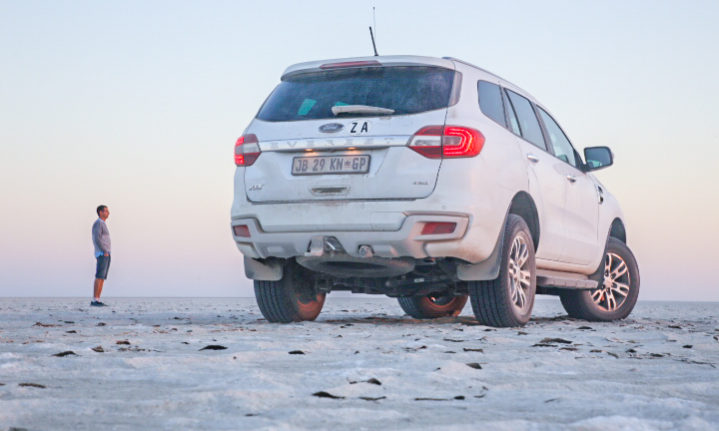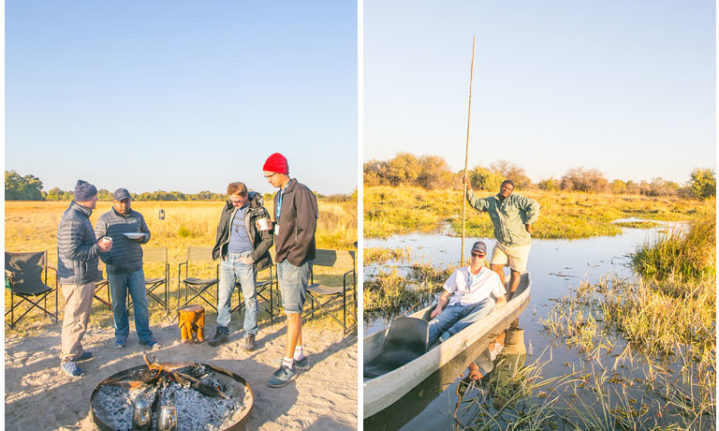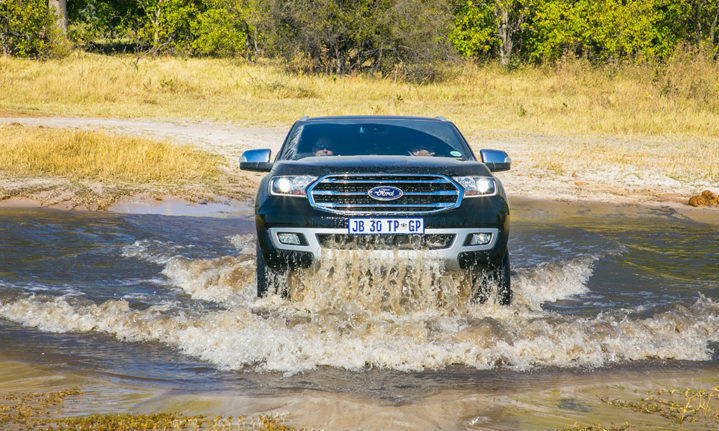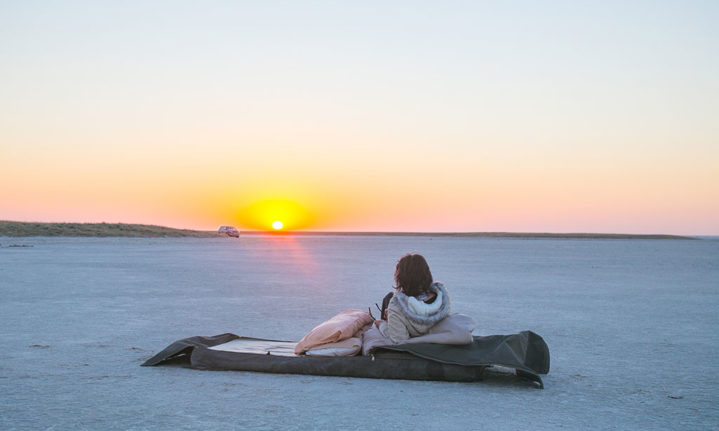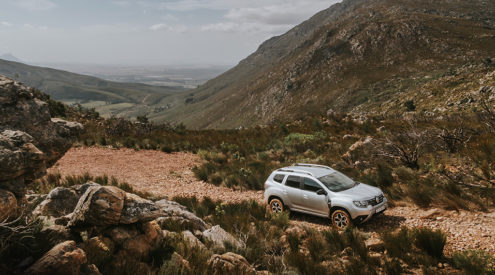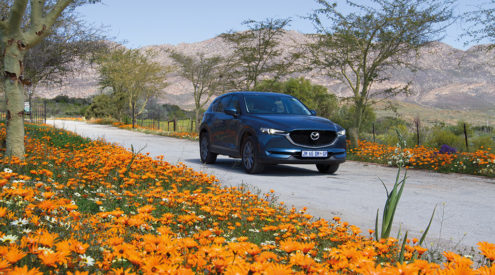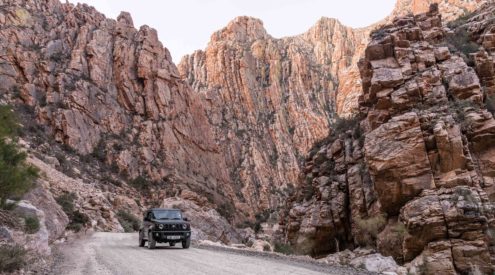‘You’ll be driving the dustiest road in the world,’ grinned Gideo Basson who looked a little dusty himself, with his curly salt-and-pepper hair sticking out of his cap and the air of a seasoned traveller. He would be leading the Ford Everest launch of its 4WD XLT and Limited range in Botswana.
I had arrived earlier that day in Maun with a few motoring journalists (aka petrol heads) including Nicol Louw, Technical Editor of Car Magazine (back in the office he has a desk down the corridor from me). From there, we took a 25-minute flight with Mack Air to Khawi on the eastern side of the Delta. As we approached the landing strip, a line of shiny Ford Everests came into view. There were seven of them for 14 journalists, plus a couple of vehicles for the Ford team, which included mechanics and a medic.

A view from the air of a mokoro trip in progress on Botswana’s Khwai River in the Delta. Image: Michelle Hardie
The last time I drove a Ford was in my 20s in 1990 when I owned a pale-blue Cortina MK3 1600. I still remember the noise the engine belted out on acceleration – a low, intense rumble (just like my dad’s Mustang) as I swept along the streets of Harare my home at the time. On idle, it emitted a burbling sound. ‘That’s one hellava car you’re driving,’ someone remarked at the time. While everyone my age was driving the latest models out of Japan and Germany, I felt cool in my Cortina.
Over the next three days, Nicol was my driving partner on a 600-kilometre route from Khwai to Makgadikgadi Pan via Maun. I felt pleased to be sitting next to an expert who could answer my questions about car stuff in the 21st century. In my everyday life, I drive a runaround made in the 20th century. I could also watch his driving skills as he put the Everest’s 4×4 abilities to the test. Maybe I’d pick up a few tips.
Also read: 6 things we love about the new Ford Ranger Raptor

Left: Early morning coffee at Khwai River View camp with (from left) Dale Reid and Minesh Bhagaloo, Denis Droppa and Nicol Louw. Right: Nicol Louw in a mokoro on the Khwai River with ‘Spark’, the poler who had a great sense of humour. Image: Michelle Hardie
‘I’m sure it’s a rock,’ I said. ‘No Michelle, it’s a hippo,’ argued Nicol. He was driving slowly past what seemed a very shallow expanse of water, where the motionless beast stood half submerged. We had just left Khwai River View, our accommodation the previous night, and were taking in a leisurely game drive on our way to the saltpans via Maun where we would stop for lunch. Gideo’s voice over the walkie talkie broke the silence. ‘Guys, don’t forget to turn off your park-assist sensors so they don’t pick up the grass.’ Being able to switch off this function is very useful, especially on game drives and in areas of thick bush, as all those bleeps can drive you mad.
We stopped for a comfort break about an hour later, and as I emerged from behind a tree, Nicol called to me, ‘It’s your turn to drive, Michelle.’ Feeling the heat, but trying to be calm, I slid into the beautifully crafted driver’s seat. The first thing I did was move it into position, at the push of a knob. Nicol’s more than 6 foot and I’m 5. I had the manoeuvre taped by the end of the trip. He also pointed out how to alter the seatbelt strap which lay across my cheek. Just a smooth push down of the mechanism altered the angle of the belt to fit my frame. This was like magic to me. Car designers have thought of everything to make driving comfort paramount. Snug in front of the wheel, I pressed a fairly large button on the left to start the engine. Ford’s keyless entry and passive start system comes standard in both models and allowed us to unlock the vehicle and start it with the key fob in Nicol’s pocket, where it stayed throughout the trip.
I was ready to go when Gideo’s voice cut into the cab. ‘Please put your vehicles in Sand Mode, we’re about to hit that dusty road I was telling you about,’ he laughed. As easy as pie, I turned a dial by the gear stick, revved the engine slightly and took off. The road was a sand pit – thick and loose with deep hollows that came up quickly. I was hesitating and Nicol knew it. ‘Don’t worry just drive, and maintain some speed,’ he urged. ‘This vehicle is built for these conditions.’ Needing no further encouragement, I put foot at a reasonable pace, my excitement mounting, and felt the confidence of this SUV as it powered through the soft layers.
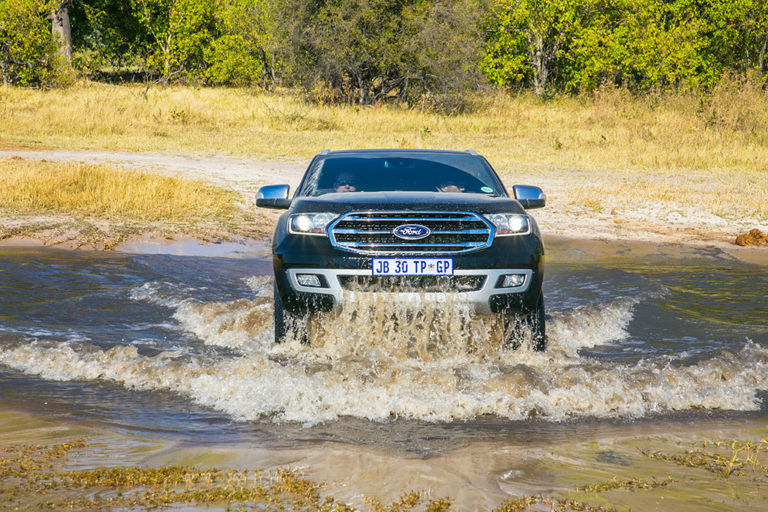
Road tripping with the seven-seater Ford Everest in Khwai, which straddles Moremi Game Reserve and Chobe National Park. Image: Michelle Hardie
The powder kicked up by vehicles ahead of us was startling – there was zero visibility. Fine white particles rose in the air and lingered. Shielded in such comfort while all about us was a blanket of thick dust was gratifying. The air-filter system purred – not a speck sneaked into the cabin, and the leather-look dashboard top remained squeaky clean. At some point, our juggernaut convoy slowed to pass an open game vehicle. Its passengers were aghast. ‘Imagine being in that,’ I chortled. The never-ending dust cloud from our vehicles had to be seen to be believed.
All too soon, we were about 40 kilometres from Maun in the Sherobe area, where cattle and goats mooched too close to the edge of the road, slowing us down, and by 1pm we were in town seated at The Tshilli Farmstall on Sir Seretse Khama Road. It was so hot I couldn’t think of eating, so I ordered an Okavango Mint Cooler while a few in the group tucked into burgers. The beef was a winner apparently; Botswana is very proud of its red meat – it’s one of the mainstays of its economy alongside tourism and diamond mining.
Our aim was to arrive in Makgadikgadi before sunset, so about an hour later we hit the A3 east. A section of the tar was littered with potholes some so deep that I thought I would do some damage if I didn’t take it really slowly. But you can’t go too slow when you’re with car enthusiasts testing the limits, so I pushed ahead and swung the wheel left to right trying to miss the deepest holes. It was like dancing –the steering was light and quick and I was having such fun! Eventually, the potholes gave way to straight smooth tar. Quickly, I found myself losing the car ahead. ‘Have you ever used Cruise Control?’ asked Nicol. ‘A long time ago,’ I said. And so began the comedy show for the car behind us … each time I braked, the 120km/h speed control was cancelled slowing the vehicle.
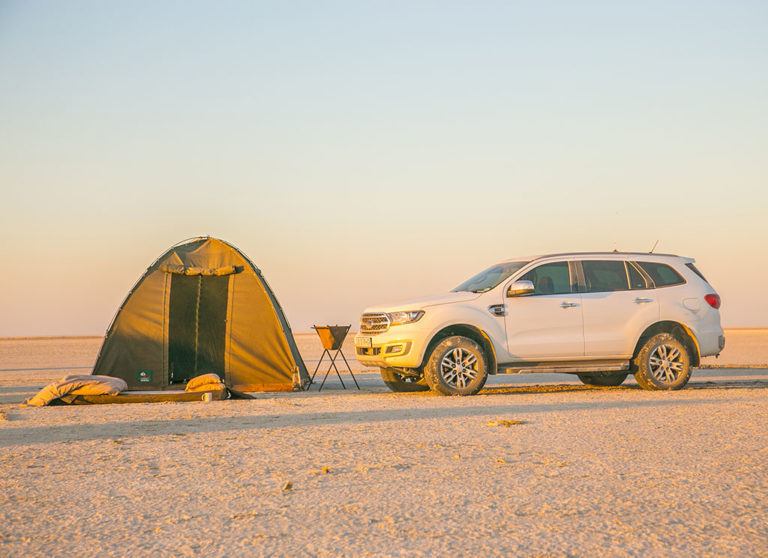
A tent, a soft bed and a reliable, comfortable 4×4 – that’s all you need on a road trip. Image: Michelle Hardie
‘So it was you behind the wheel,’ smiled Neale Hill, managing director of Ford SA, at dinner that night. Cruise Control is in both models but the Limited includes Adaptive Cruise Control with Forward Collision Alert, which recognises pedestrians plus detects other vehicles. ‘This is what driverless cars are all about,’ said Nicol, as I lamented that I couldn’t resist controlling my speed and it would take time for me to build up trust in allowing the vehicle to take over.
The last leg before we reached Makgadikgadi was a jeep track off the A3. It wound through golden savannah inhabited by wild horses – an unexpected sight – then the landscape got even more extraordinary as we crested a rise and the salt pan came into view. The chalky white crust of the Makgadikgadi, which was a lake a few 1000 years ago, extended as far as I could see. Its essence is the definition of ‘pure silence’. I felt stilled there and wanted to stay for at least a week, sleeping under the canopy of stars. The reverie was over too soon and the next day we drove back to Maun to catch our flight. On the way, Nicol tested the Everest’s Lane Keeping Aid, a safety feature that worked really well. Each time he veered onto the right side of the road an alarm went off. Eventually, a voice suggested he take a break at the nearest stop! We had a good laugh, but, seriously, I think this safety feature should be a prerequisite in the trucking industry.

Everyone should sleep under the stars on the Makgadikgadi at least once in their lifetime. Image: Nicol Louw
So which one did I prefer – The XLT or the Limited? I really couldn’t tell the difference driving them, but the inside of the Limited looked plusher and its seats felt plumper and more luxurious. I also liked the stitching detail on the Limited’s dashboard which gives the cabin a more handcrafted, well-made feel.
Techie facts
Model: Ford Everest 2,0 BiT 10AT 4×4 XLT (and Limited)
Price: R687 700 (XLT) and R761 200 (Limited)
Engine: 2,0-litre, 4-cyl, turbocharged diesel
Power: 157 kW @ 3 750 r/min
Torque: 500 N.m @ 1 500-2 000 r/min
Fuel Consumption: 7,6 L/100 km
CO2: 201 g/km
Transmission: 10-spd auto
See the full Ford Everest price and specs here.

Nicol Louw of Car magazine with the Ford Everest XLT on the Makgadikgadi salt pan in Botswana. Image: Michelle Hardie









